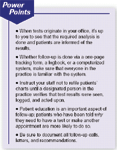Article
Follow-up tips for a safe, efficient practice
A high-quality tracking system can help you provide better patient care and keep you out of the courtroom.
"On many occasions-and I mean many-I've found myself before the Board of Medical Examiners with doctors who have failed to follow up on test results," says Steven I. Kern, a health law attorney in Bridgewater, NJ.

Here's how to develop a smooth-running follow-up system, along with some cautionary words about the consequences of not having such a system in place.
When a test originates in your office-you draw blood or send a specimen to be biopsied-it's your responsibility to see that the required analysis is done and that the patient gets the results. The mechanism for doing this can be as simple or as complex as your inclinations, finances, and practice setup allow. Among the possibilities:
Another advantage of a computerized system is that it can be interfaced with those of labs and other venues that will be sending you test results. And it can include an automated telecommunications system to report normal results to patients and to indicate if and when a follow-up appointment is required. But don't leave a voice mail message-automated or otherwise-to indicate that results are abnormal: Not only can't you be sure that the patient will hear the message, you'll be taking a chance that someone else will-a clear violation of your patient's privacy.
The drawback of computer systems is that the human element gets short shrift, says Lawrence W. Vernaglia, a health law attorney in Boston. "We've become so used to clicking OK on a computer, there's a danger that we'll click OK on a test result we haven't read. That's less likely to happen with a piece of paper."
Making sure everyone's on board
If you order a test, don't refile the chart. Keep it in a designated location, arranged according to the date that results are due, suggests Kern. When the result comes in, a staffer should attach the report to the chart and give both to you for review and further recommendations. "This is as good an approach as any, and it requires no technology other than a paper clip," Kern notes.





